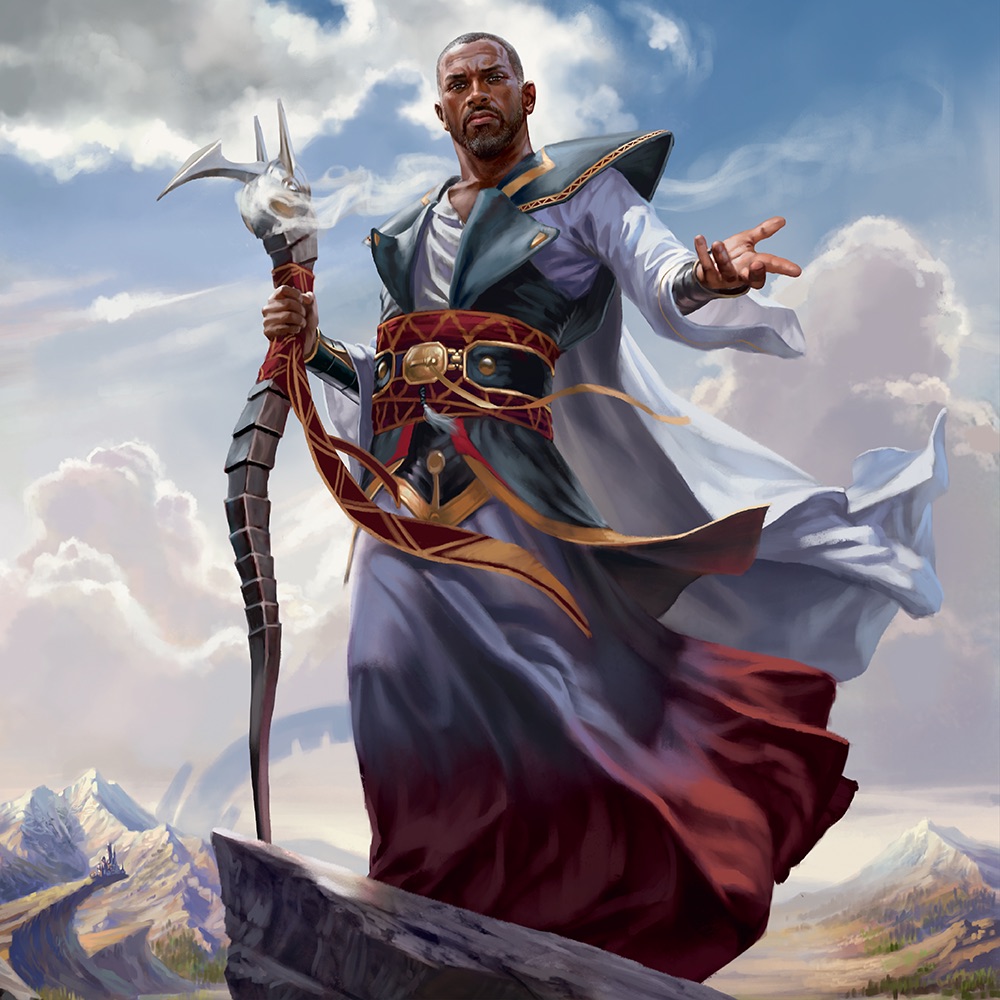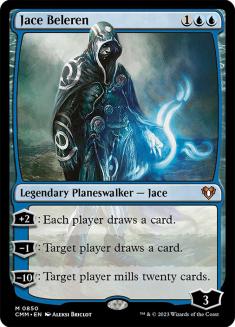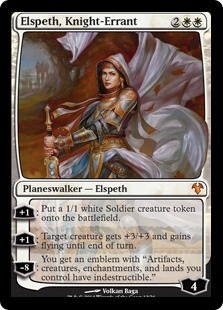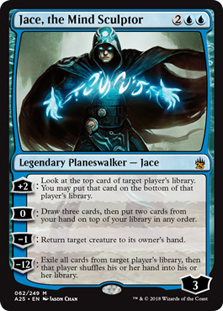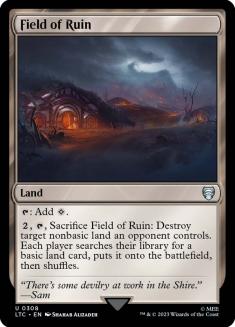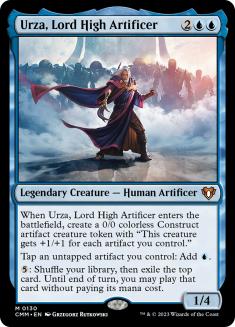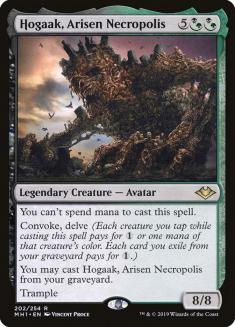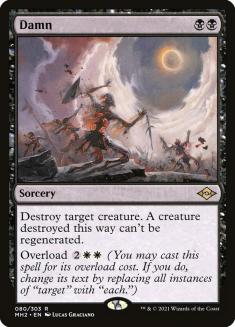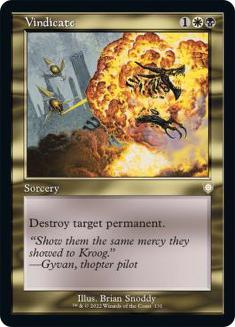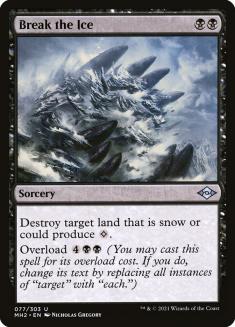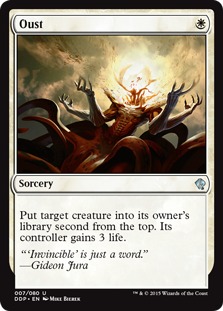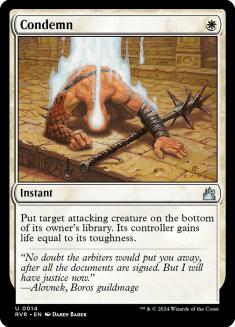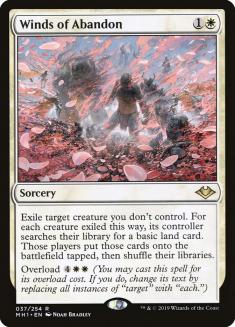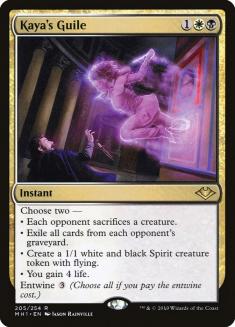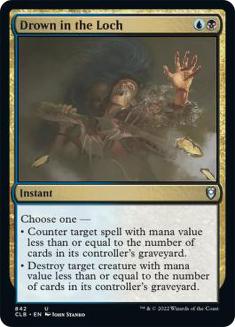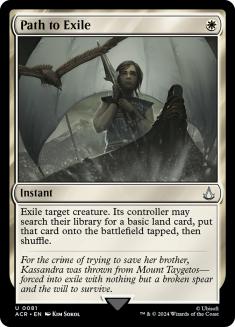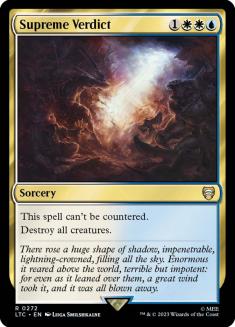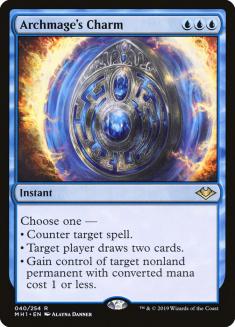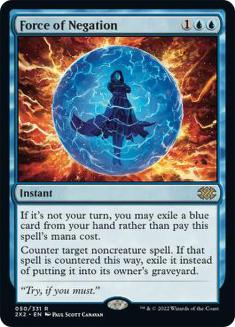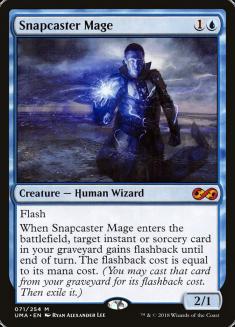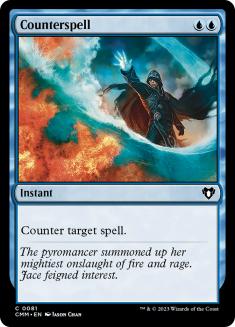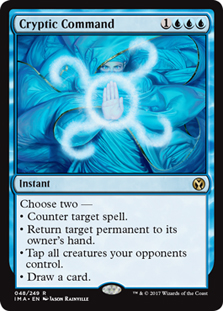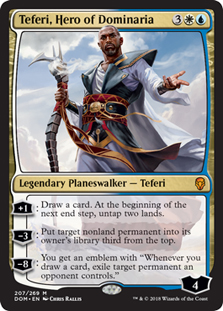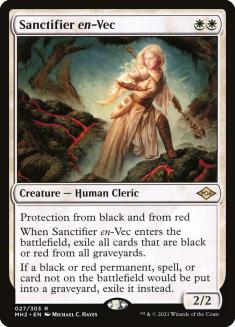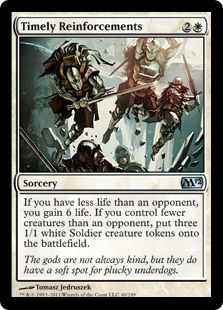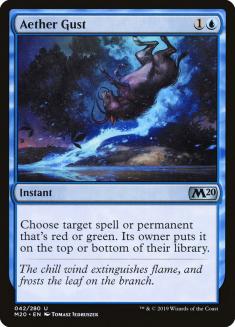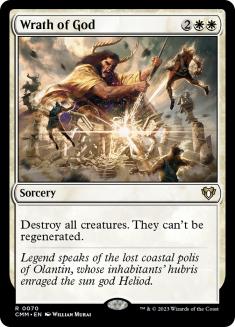Choosing a control deck in Modern has never been this difficult. The metagame typically dictates which direction control players must take and we go from there. Esper Charm has been legal for quite some time; however, Azorius Control remained the top dog until recently. Even with cards being added like Fatal Push, Drown in the Loch, and Kaya’s Guile, Esper Control remained the fringe choice among players like me. That’s partially due to the manabase, but mainly because Azorius Control, even with its removal weaknesses, was able to effectively attack the format over the last few years.
Teferi, Hero of Dominaria; Jace, the Mind Sculptor; and Teferi, Time Raveler were big reasons why Azorius Control rose to a prominent place in Modern. Before the arrival of these three planeswalkers, it and Jeskai Control were laughably weak, even though many of us still decided to pay money to play in tournaments with them. I was fine summoning a Jace Beleren and Elspeth, Knight-Errant, even piloting the pair to a 13-2 record at a Grand Prix, but that was largely due to getting paired against Affinity seven times. In a typical event, control needed some better permanents to have a shot at being viable.
The better planeswalkers immediately propelled Azorius Control up, with little competition from other control options. Jeskai and Esper Control were around, but the three-color manabase wasn’t needed to take on the bulk of the format. Field of Ruin was another fantastic addition and draw to a two-color manabase, immediately making Mono-Green Tron a good matchup, where it was unwinnable before its arrival. Grand Prix, SCG Tour Opens, and competitive tournaments around the world saw Azorius Control take titles, not in record numbers, but enough to remove some of the stigma behind the archetype in the highly volatile format. Life was decent for control decks for a while, but the game has changed with the arrival of the Modern Horizons series.
Modern Horizons and Modern Horizons 2 were developed to intentionally change the format in fundamental ways. These stress tests proved to be more than it could handle at times, resulting in multiple bannings from the first Modern Horizons set. Some of the cards were blatantly overpowered, and even though Urza, Lord High Artificer is legal, Mox Opal and Arcum’s Astrolabe were sacrificed for its crimes against the format. This set did not do much for control, outside of the much-appreciated Force of Negation. It was full of cards that pushed artifacts over the edge, graveyard strategies, and some powerful permanents that did not get added to any of my decklists. After that level of betrayal, I did not expect much from Modern Horizons 2. I was wrong.
Modern Horizons 2 showered control players in options for Azorius Control, Esper Control, and Stoneblade decks. Every week added new weapons to the control arsenal, pulling me toward each of the three archetypes at different phases of the preview season. Damn, Vindicate, and Break the Ice made it clear that Esper Control was the deck of choice for me moving forward. Even though I’m singing the historical praises of Azorius Control, Esper Control recently overtook it as the Modern control deck of choice.
The removal of Azorius Control has been utterly embarrassing since I started playing it. Oust, Condemn, and Winds of Abandon are not it, regardless of how hard we wish them to be. The weakness of the supplemental removal was not enough to derail Azorius Control until Esper Control got its manabase act together. With a little help, the damage from the lands lessened and the natural lifegain that was attached to Kaya’s Guile was adequate to make up for the minimal fetchlands / shocklands. Fatal Push and Drown in the Loch was putting on a show in Modern, representing effective removal in the early-game, with great late-game utility. With the superior black removal on full display, I thought Azorius Control would never see the competitive light of day again.
Solitude felt like it came out of nowhere, even though we saw the powerful Elemental Incarnations before it. We all thought white was going to receive some nonsense, something that would not get played in even the most casual settings. What we received, however, was a removal spell that’s nearly as good as Path to Exile, which I never thought I would see in Modern.
It exiles, like Path to Exile, for the cost of zero mana, with much bigger upside in the late-game. Like Path to Exile, Solitude is a less painful cast after the first few turns. With Path to Exile, an extra land for the opponent on Turn 4 is not as bad as on Turn 1. With Solitude, having the opportunity to hardcast it, exile a creature, and gain a bunch of life on Turn 5 is extremely powerful. It has been an absolute all-star against most matchups, coming through in the clutch when resources are low, while helping get back in games where the attached lifegain shines. Even though it can be housed in Esper Control, the competition there is too fierce.
Control players have already cut Path to Exile out of Esper, for good reason. The black removal is cheap and efficient, with Kaya’s Guile and Drown in the Loch having other powerful modes. There’s simply no room for Solitude in this deck, nor would it be able to effectively cast it like Azorius Control can. There are more white spells and room in Azorius Control, making it a staple there and affecting my overall deck choice decision. The important preface is that Esper Control is still great, Esper and Azorius Stoneblade are both viable, and the return of Counterspell is the basis for this entire discussion. Blue decks are conquering Magic Online right now, and we need to have as much fun with them before Wizards of the Coast (WotC) realize their reprint mistake.
Creatures (7)
Planeswalkers (7)
Lands (25)
Spells (21)

I had fun with Esper Control for about a month, but it was time to put Solitude to the test. So far, it has passed with flying colors, filling the one true weakness of Azorius Control. I’ve enjoyed seeing a deadly one-drop, like Ragavan, Nimble Pilferer, not run away with the game if a Path to Exile was not handy. Having seven ways to dispatch it has saved the archetype, not to mention the array of deadly two-drops that resolved before two blue mana was available. Being on the draw against aggro decks was a struggle, until now.
The metagame is still very creature-driven, making the upgrades to Azorius Control very important for its own relevancy. Without a card like Solitude, the only viable option would have been a third color for black removal. Now that Path to Exile has assistance on Turn 1, the rest of the deck has transformed to what it always wanted to be. Four copies of Counterspell dominate the two-mana slot, empowered by the strong removal that can greet creatures before it arrives. This has eased the burden sweepers have in control. It’s no longer a draw-or-die scenario against aggro decks by Turn 4. Battlefields have been more manageable, with play patterns allowing me to pitch a Supreme Verdict to a Force of Negation or Solitude without worrying about being overrun for my decision.
The rest of the deck continues with a clean, control curve. Archmage’s Charm, hardcast Force of Negation, and the start of flashback by Snapcaster Mage kick in on Turn 3, opening the floodgates against all valid archetypes of the format. Teferi, Time Raveler is still a beast in the early-game but got even better with the free spells that protect you on the opponent’s turn. Resolving the broken planeswalker, bouncing a threat, drawing a card, and then removing a threat with Solitude, has been a normal series of plays in the last week.
Turn 3 is great, but the real fun starts right after.
I cranked the number of Snapcaster Mage to four to take full advantage of Counterspell and the return of Riptide Laboratory. Riptide Laboratory is only a one-of in the deck, but it has already provided me victories with minimal activations. Wizards find their way into control decks in the older formats. Snapcaster Mage is the most valuable target, while Vendilion Clique has found its way back to my 75 (I replaced Monastery Mentor in the sideboard since the deck now thrives on flash-based permanents).
Snapcaster Mage, Vendilion Clique, and Solitude all join the instant-speed team, providing an array of options when all the mana is untapped. Even though Teferi, Hero of Dominaria and Teferi, Time Raveler require some mana investment, each aids the Flash plan, with one giving Supreme Verdict a boost and the other untapping two lands. Both Snapcaster Mage and Vendilion Clique have been getting the job done, especially with Riptide Laboratory in the mix.
With four lands comes the king himself, Jace, the Mind Sculptor. As with Teferi, Time Raveler, tapping out for it isn’t as scary as it used to be. Having multiple ways to defend your planeswalkers with zero untapped resources is a game-changer in Modern. I’m currently playing three copies of Solitude, but after seeing it protect Jace, the Mind Sculptor over and over on Turn 4, it may be time to max out the number of copies I play.
Cryptic Command is the final piece of the disruption puzzle and will always have a home in Azorius Control. It’s reduced to a two-of here, but that number always fluctuates by one, depending on the metagame. When a bunch of players are trying to counter spells, the four-mana option loses some real estate. Cards like Mystical Dispute are becoming much more popular, and it feels bad to be on the receiving end of that mana disadvantage.
The final set of plays, outside of Snapcaster Mage shenanigans and multi-spell turns, arrives on Turn 5. Teferi, Hero of Dominaria has passed Jace, the Mind Sculptor for an important reason. As a multicolor spell, it pitches to Force of Negation and Solitude. There are plenty of extra blue spells in control decks for Force of Negation to be great; however, it takes purposeful deck design to give Solitude a chance to shine. Jace, the Mind Sculptor may be the superior planeswalker, but only by the smallest of fractions. Since it cannot be thrown to the Solitude gods, Teferi, Hero of Dominaria becomes the three-of win condition.
Solitude is a five-mana spell, even though we like to cast it for free occasionally. One thing I was surprised about the most was the frequency of it being cast for its full mana cost. My late-game is riddled by it arriving for five mana, Snapcaster Mage returning the pile of blue disruption resting in the graveyard, and planeswalkers remaining on the battlefield far more often than they did in the past.
This is all thanks to Modern Horizons 2, which brought us the tools to make Azorius Control viable once again. Even the sideboard got some love from the new set, replacing cards that I thought I would never abandon.
Due to the strength of blue decks, my sideboard is geared to answer with a flurry of additional countermagic. Mystical Dispute is a two-of with Dovin’s Veto, making the grand total of blue disruption a whopping fifteen cards in the sideboarded games. This is without considering Snapcaster Mage and Vendilion Clique, both of which assist in that category. That is an absurd number, one that would only be in my dreams to play, but it is reality.
The truth is the aggro matchup is so good Game 1 and only needs a few spells to put it over the edge. New addition Sanctifier en-Vec provides a weapon against red-based aggro while replacing the need for Rest in Peace. Rest in Peace is still the superior graveyard hate spell across most formats; however, it does get a bit awkward with four Snapcaster Mage. Sanctifier en-Vec does double duty, knocking out problematic graveyard decks while making combat impossible for red and black creatures.
I still have a few copies of Surgical Extraction for insurance purposes. It still feels too good to Field of Ruin an Urzatron piece and remove all copies or hit a vital combo piece in other matchups.
The rest of the sideboard strengthens aggressive matchups. Aether Gust, Timely Reinforcements, Celestial Purge, and a couple of sweepers enhance the white-based removal of the maindeck, which is already strong. I have been loving the four-sweeper sideboarded games, backed by the significant lifegain, against decks that employ multiple one-drops.
Azorius Control is my current deck of choice, though Stoneblade has been impressing me with its similar, new additions. Even though Esper Control has slid down my priority list, I do not think you can go wrong with one of these three archetypes.
While Counterspell is legal in Modern, these blue decks have the tools for dominance.

